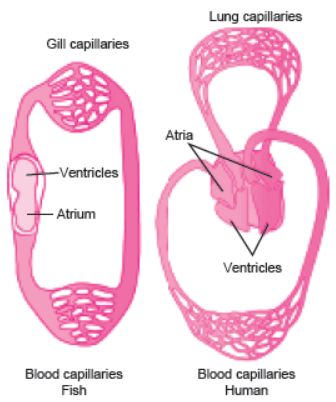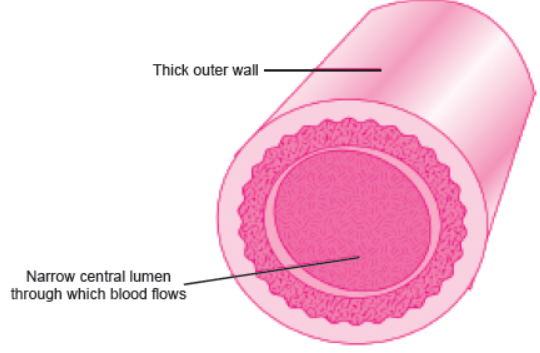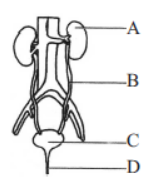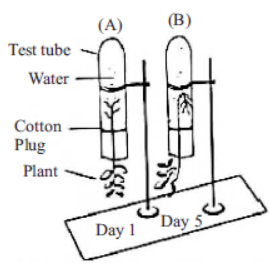Refer to CBSE Class 10 Biology Life Processes MCQs Set F provided below available for download in Pdf. The MCQ Questions for Class 10 Science with answers are aligned as per the latest syllabus and exam pattern suggested by CBSE, NCERT and KVS. Chapter 5 Life Processes Class 10 MCQ are an important part of exams for Class 10 Science and if practiced properly can help you to improve your understanding and get higher marks. Refer to more Chapter-wise MCQs for CBSE Class 10 Science and also download more latest study material for all subjects
MCQ for Class 10 Science Chapter 5 Life Processes
Class 10 Science students should refer to the following multiple-choice questions with answers for Chapter 5 Life Processes in Class 10.
Chapter 5 Life Processes MCQ Questions Class 10 Science with Answers
Question: Which of the following is not a characteristic of an organism.
a) They can grow
b) They respond to changs in environment
c) They release energy during respiration
d) They do not need food, and water
Answer: d
Question: In order to de-starch the leaves for an experiment to show that sunlight is necessary for photosynthesis
a) Leaves are kept in alcohol and boiled in a water bath
b) Leaves are soaked in iodine for two hours
c) Plant with the leaves is kept in a dark room for 24 hours
d) Plant with the leaves exposed to light of a lamp, a night before the experiment
Answer: c
Question: Autotrophic organisms include
a) Bacteria and virus
b) Bacteria and fungi
c) Green plants and some bacteria
d) Green plants and all bacteria
Answer: c
Question: Photosynthesis takes place in the presence of
a) Water and sunlight
b) Oxygen and sunlight
c) CO2, water and sunlight
d) CO2 and O2
Answer: c
Question: Compensation point refers to the intensity of light at which
a) Rate of respiration = rate of photosynthesis
b) Rate of respiration > rate of photosynthesis
c) Rate of respiration < Rate of photosynthesis
d) None of the above is correct
Answer: a
Question: Which of the following statements about the autotrophs is incorrect:
a) They synthesize carbohydrates from carbon dioxide and water in the presence of sunlight and chlorophyll
b) They store carbohydrates in the form of starch
c) They convert carbon dioxide and water into carbohydrates in the absence of sunlight
d) They constitute the first trophic level in food chains
Answer: c
Question: Which is the correct sequence of body parts in the human alimentary canal?
a) Mouth → stomach → small intestine → large intestine → oesophagus
b) Mouth → oesophagus → stomach → small intestine → large intestine
c) Mouth → stomach → oesophagus → small intestine → large intestine
d) Mouth → oesophagus → stomach → large intestine → small intestine
Answer: b
Question: What are the products obtained by anaerobic respiration in plants?
a) Lactic acid + Energy
b) Carbon dioxide + Water + Energy
c) Ethanol + Carbon dioxide + Energy
d) Pyruvate
Answer: b
Question: When a few drops of iodine solution are added to rice water, the solution turns blue- black in colour. This indicates that rice water contains:
a) fats
b) complex proteins
c) starch
d) simple proteins
Answer: c
Question: What is the percentage of the oxygen in the expired air when a person is resting:
a) 12%
b) 16%
c) 20%
d) 24%
Answer: b
Question: In which of the following vertebrate group groups, does heart not pump oxygenated blood to different parts of the body?
a) Pisces and amphibians
b) Amphibians and reptiles
c) Amphibians only
d) Pisces only
Answer: d
Question: The characteristic processes observed in anaerobic respiration are
i) presence of oxygen
ii) release of carbon dioxide
iii) release of energy
iv) release of lactic acid
a) i), ii) only
b) i), ii), iii) only
c) ii), iii), iv) only
d) iv) only
Answer: c
Question: Digestion of food in human starts from
a) duodenum
b) small intestine
c) mouth
d) large intestine
Answer: c
Question: The filtration units of kidneys are called
a) ureter
b) urethra
c) neurons
d) nephrons
Answer: d
Question: Oxygen liberated during photosynthesis comes from:
a) Water
b) Chlorophyll
c) Carbon dioxide
d) Glucose
Answer: a
Question: In amoeba the digestion is intracellular because
a) amoeba is unicellular
b) amoeba is multicellular
c) amoeba is found is pond
d) amoeba is microscopic animal
Answer: a
Question: In amoeba, food is digested in the:
a) food vacuole
b) mitochondria
c) pseudopodia
d) chloroplast
Answer: a
Question: While preparing good temporary mount of leaf peel to observe stomata, care should be taken to avoid
a) Adding glycerine to the slide
b) Staining the peel with safranin
c) Having air bubbles in the slide
d) Using water to wash the slide
Answer: c
Question: --------------the key organ of, cardiovascular system which acts as a muscular pump.
a) Kidney
b) Heart
c) Lungs
d) Stomach
Answer: b
Question: Wavelength of visible light is
a) 200 - 400 nm
b) 400 - 700 nm
c) 700 - 900 nm
d) 100 - 200 nm
Answer: b
Question: Most of the photosynthesis (80%) which takes place on this earth is carried out by
a) green plants on land
b) algae present in fresh water
c) algae found in ocean
d) algae present in ocean and fresh water sources.
Answer: d
Question: In which of the following groups of organisms, food materials are broken down outside the body and absorbed?
a) Mushroom, green plants, Amoeba
b) Yeast, mushroom, bread mould
c) Paramecium, Amoeba, Cuscuta
d) Cuscuta, lice, tapeworm
Answer: b
Question: The breakdown of pyruvate to give carbon dioxide,water and energy takes place in
a) cytoplasm
b) mitochondria
c) chloroplast
d) nucleus
Answer: b
Question: The image shows the circulation of blood in fishes and humans.

How is the circulation of blood in fish different from that in humans?
a) The flow of blood in fish is unidirectional.
b) The heart of fish has more chambers compared to that of a human.
c) The blood goes through heart only once in fishes.
d) The heart in fish is bigger in size
Answer: d
Question: The image shows the structure of an artery.

Which statement supports the likely reason for thick walls in arteries?
a) To sustain the high-pressure blood from the heart.
b) To carry large amount of blood.
c) To ensure blood flows in only one direction.
d) To allow easy exchange of gases with cells.
Answer: a
Question: Select the correct statement
a) Heterotrophs do not synthesise their own food
b) Heterotrophs utilise solar energy for photosynthesis
c) Heterotrophs synthesise their own food
d) Heterotrophs are capable of converting carbon dioxide and water into carbohydrates
Answer: a
Question: Select the groups of organisms where food material is broken down outside the body and absorbed
a) Mushroom, green plants, amoeba
b) Yeast, mushroom, bread mould
c) Paramecium, amoeba, cuscuta
d) Cuscuta, lice, tapeworm
Answer: b
Question: Which of the following is the important characteristic of Emphysema:
a) Destruction of the alveolar wall and air sacs in the lungs are damaged.
b) Increase in the growth of the lung tissue.
c) Inflammation in the wall of bronchi.
d) Thickening of the artery walls of the lungs.
Answer: a
Question: The image shows the bread moulds on a bread How do these fungi obtain nutrition?
a) by eating the bread on which it is growing
b) by using nutrients from the bread to prepare their own food
c) by breaking down the nutrients of bread and then absorbing them
d) by allowing other organisms to grow on the bread and then consuming them
Answer: a
Question: Choose the forms in which most plants absorb nitrogen
(i) Proteins
(ii) Nitrates and Nitrites
(iii) Urea
(iv) Atmospheric nitrogen
a) (i) and (ii)
b) (ii) and (iii)
c) (iii) and (iv)
d) (i) and (iv)
Answer: b
Question: Single circulation i.e., blood flows through the heart only once during one cycle of passage through the body, is exhibited by:
a) Labeo, Chameleon, Salamander
b) Hippocampus, Exocoetus, Anabas
c) Hyla, Rana, Draco
d) Whale, Dolphin, Turtle
Answer: d
Question: Single circulation, i.e., blood flows through the heart only once during one cycle of passage through the body, is exhibited by:
a) Labeo, Chameleon, Salamander
b) Hippocampus, Exocoetus, Anabas
c) Hyla, Rana, Draco
d) whale, dolphin, turtle
Answer: b
Question: CO2 acceptor during dark reaction of photosynthesis is
a) RUBP
b) PEP
c) NADPH
d) ATP
Answer: a
Question: When temperature increases, the rate of photosynthesis
a) Increases
b) Decreases
c) First increases then decreases again
d) Remains the same
Answer: c
Question: Digestion of food starts from which organ of the human digestive system?
a) mouth due to the presence of saliva
b) oesophagus that moves the food in gut
c) that releases juices for fat breakdown
d) which helps in mixing food with digestive juices
Answer: c
Question: A leaf is boiled in alcohol before using iodine for starch test in order to
a) Dissolve starch
b) Dissolve chlorophyll
c) Soften the leaf
d) Make it react with iodine
Answer: b
Question: Which of the following statement(s) is (are) correct?
(i) Pyruvate can be converted into ethanol and carbon dioxide by yeast
(ii) Fermentation takes place in aerobic bacteria
(iii) Fermentation takes place in mitochondria
(iv) Fermentation is a form of anaerobic respiration
a) (i) and (iii)
b) (ii) and (iv)
c) (i) and (iv)
d) (ii) and (iii)
Answer: c
Question: In the list of organisms given below, those that reproduce by the asexual method are:
(i) Banana (ii) Dog
(iii) Yeast (iv) Amoeba
a) (ii) and (iv)
b) (i), (iii) and (iv)
c) (i) and (iv)
d) (ii), (iii) and (iv)
Answer: b
Question: Select the incorrect statement about the autotrophs
a) They synthesise carbohydrates from carbon dioxide and water in the presence of sunlight and chlorophyll
b) They store carbohydrates in the form of starch
c) They convert carbon dioxide and water into carbohydrates in the absence of sunlight
d) They constitute the first trophic level
Answer: c
Question: In artificial kidney, which substance passes from the blood to the dialysis fluid?
a) Urea
b) Heart
c) Uric acid
d) Creatinine
Answer: a
Question: Where are proteins first digested in the alimentary canal?
a) Small intestine
b) Oesophagus
c) Mouth
d) Stomach
Answer: d
Question: Choose the event that does not occur in photosynthesis
a) Absorption of light energy by chlorophyll
b) Reduction of carbon dioxide to carbohydrates
c) Oxidation of carbon to carbon dioxide
d) Conversion of light energy to chemical energy
Answer: c
Question: During respiration exchange of gases take place in
a) Trachea an Larynx
b) Alveoli of Lungs
c) Alveoli and Throat
d) Throat and Larynx
Answer: b
Question: Chlorophyll is present in
a) Intrathylakoid space
b) Thylakoid membrane
c) Intermembrane space
d) Inner membrane of envelope
Answer: b
Question: Which of the following statement(s) is/are true about heart?
(i) Left atrium receives oxygenated blood from different parts of body while right atrium receives deoxygenated blood from lungs
(ii) Left ventricle pumps oxygenated blood to different body parts while right ventricle pumps deoxygenated blood to lungs
(iii) Left atrium transfers oxygenated blood to right ventricle which sends it to different body parts
(iv) Right atrium receives deoxygenated blood from different parts of the body while left ventricle pumps oxygenated blood to different parts of the body
a) (i)
b) (ii)
c) (ii) and (iv)
d) (i) and (iii)
Answer: c
Question: Chemicals present in the tobacco smoke lead to the breakdown of the elastic tissue in the alveoli. Name this specific condition.
a) Heart disease
b) Emphysema
c) Bronchitis
d) Lung cancer
Answer: b
Question: Before removing chlorophyll, the leaf is boiled in which one of the following solvent
a) Formalin
b) Water
c) Alcohol
d) Glycerine
Answer: c
Question: The diagram below represents a group of organs in the human body. Urine leaves the urinary bladder by passing through this structure labelled

a) A
b) B
c) C
d) D
Answer: d
Question: Observe the experimental sets [A] & [B]. Observe the test tube A & B. From the list given below, choose the combination of responses of shoot and root that are observed in B.

a) Positive phototropism and positive geotropism
b) Negative phototropism and positive geotropism
c) Positive phototropism and negative geotropism
d) Only negative phototropism
Answer: a
Question: Find out the structure which is not present in chloroplast
a) Granum
b) Stroma
c) Cristae
d) Thylakoid
Answer: c
Question: Choose the correct statement that describes arteries.
a) They have thick elastic walls, blood flows under high pressure; collect blood from different organs and bring it back to the heart
b) They have thin walls with valves inside, blood flows under low pressure and carry blood away from the heart to various organs of the body
c) They have thick elastic walls, blood flows under low pressure; carry blood from the heart to various organs of the body
d) They have thick elastic walls without valves inside, blood flows under high pressure and carry blood away from the heart to different parts of the body.
Answer: d
Following questions consists of two statements – Assertion (A) and Reason (R). Answer these questions selecting the appropriate option given below:
A. Both assertion and reason are true, and reason is the correct explanation of assertion.
B. Both assertion and reason are true, but reason is not the correct explanation of assertion.
C. Assertion is true but reason is false.
D. Assertion is false and reason is true.
1) Assertion : kidneys perform a dual function in our body.
Reason: selective reabsorption occurs in the glomerulus.
Answer: c
2) Assertion : mammals and birds have four chambered heart .
Reason : mammals and birds are warm blooded.
Answer: a
Question: Assertion: Nutrition, respiration, transportation, excretion, growth are essential processes for our life.
Reason: We cannot survive without these processes.
Answer: a
Question: Assertion: Our body can exchange energy and matter with the surrounding.
Reason: Our body is a closed system.
Answer: c
6) Assertion : arteries always carry oxygenated blood.
Reason: arteries transport blood from the heart to different parts of the body.
Answer: a
7) Assertion : the left atrium and left ventricle are completely separated from the right atrium and the right ventricle.
Reason : oxygenated and deoxygenated blood never mix with each other inside the heart
Answer: a
Question: Assertion: Blood of insects is colourless.
Reason: The blood of insect does not play any role in transport of oxygen.
Answer: b
Question: Assertion: Blood pressure is arterial blood pressure.
Reason: It is measured by sphygmomanometer.
Answer: b
Question: Assertion: Chloroplast help in photosynthesis.
Reason: Mitochondria have enzymes for dark reaction.
Answer: c
Question: Assertion: During physiology of excretion, deamination does not take place in liver.
Reason: Deamination is a process to make use of excess of amino acids which can not be incorporated into protoplasm.
Answer: d
Question: Assertion: Photorespiration decreases net photosynthesis.
Reason: Rate of respiration in dark and light is almost same in all plants.
Answer: c
MCQs for Chapter 5 Life Processes Science Class 10
Expert teachers of studiestoday have referred to NCERT book for Class 10 Science to develop the Science Class 10 MCQs. If you download MCQs with answers for the above chapter you will get higher and better marks in Class 10 test and exams in the current year as you will be able to have stronger understanding of all concepts. Daily Multiple Choice Questions practice of Science will help students to have stronger understanding of all concepts and also make them expert on all critical topics. After solving the questions given in the MCQs which have been developed as per latest books also refer to the NCERT solutions for Class 10 Science. We have also provided lot of MCQ questions for Class 10 Science so that you can solve questions relating to all topics given in each chapter. After solving these you should also refer to Class 10 Science MCQ Test for the same chapter.
You can download the CBSE MCQs for Class 10 Science Chapter 5 Life Processes for latest session from StudiesToday.com
Yes, the MCQs issued by CBSE for Class 10 Science Chapter 5 Life Processes have been made available here for latest academic session
You can find CBSE Class 10 Science Chapter 5 Life Processes MCQs on educational websites like studiestoday.com, online tutoring platforms, and in sample question papers provided on this website.
To prepare for Chapter 5 Life Processes MCQs, refer to the concepts links provided by our teachers and download sample papers for free.
Yes, there are many online resources that we have provided on studiestoday.com available such as practice worksheets, question papers, and online tests for learning MCQs for Class 10 Science Chapter 5 Life Processes

